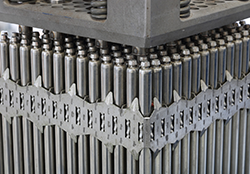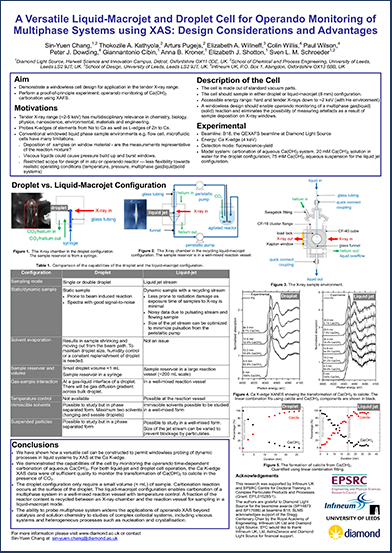___________________________________
Industrial Liaison Group:
Tel: +44 (0) 1235 778797
E-mail: industry@diamond.ac.uk

Spectroscopy is a powerful research technique used to measure the electromagnetic radiation absorbed or emitted by atoms as they move from one energy state to another; this enables you to determine the composition of an object based on the characteristic response at different wavelengths.
As atoms and molecules have unique spectra, using this method allows you to easily identify them and explore their physical properties such as temperature, mass and composition.
Some of the applications for this technique include:
♦ Catalyst design ♦ Energy storage ♦ Drug Development ♦ Lubricants ♦ Material Design ♦ Corrosion
For more detail on this powerful technique, read our in-depth Spectroscopy article.
You can also find our more about how we use Spectroscopy for industrial research here.

Teams from the University of Liverpool and UCL have used XPS at Diamond to study Transparent Conducting Oxides based on doped In2O3 and other metal oxides. The insight acquired will hopefully lead to better and cheaper products in the electronics and glass coatings markets. To find out more, read our case study.

This study, conducted through the Newton Fund programme, explores the use of a bentonite-based catalyst to produce biofuel from palm oil waste. Scientists from LIPI in Indonesia used in situ XAS to understand how the catalyst works under real conditions. To find out more, read our case study.
 IR Spectroscopy has provided the potential for new ways to identify cancer cells by screening tissue and cytology samples for early diagnosis. To find out more read our case study.
IR Spectroscopy has provided the potential for new ways to identify cancer cells by screening tissue and cytology samples for early diagnosis. To find out more read our case study.

Using XAS spectroscopy technique, a team from the National Nuclear Laboratory were able to investigate the oxidation state of Fe in Zircaloy fuel cladding material, The insights will aid the development of future materials, to increase efficiency and maintain/improve reactor safety. To find out more, read our case study.

Researchers from the SLRI synchrotron in Thailand and Algaeba have been exploring a new form of food supplement, using chlorophyll from algae. The aim is to produce a natural plant-based food supplement to replicate the qualities of meat. To find out more, read our case study.
 XAS and XMDC at Diamond have opened up new avenues of research to stop the build-up of a neurotoxic substance associated with damage caused by Alzheimer's. To find out more, read our case study.
XAS and XMDC at Diamond have opened up new avenues of research to stop the build-up of a neurotoxic substance associated with damage caused by Alzheimer's. To find out more, read our case study.
 Industrial Research on Catalysis using XAS at Diamond.
Industrial Research on Catalysis using XAS at Diamond.
 A versatile liquid-macrojet and droplet cell for operando monitoring of multiphase systems using XAS: Design considerations and advantages.
A versatile liquid-macrojet and droplet cell for operando monitoring of multiphase systems using XAS: Design considerations and advantages.
 An ambient-pressure gas-flow electron-yield cell for operando XAFS studies of liquid jets with tender X-rays.
An ambient-pressure gas-flow electron-yield cell for operando XAFS studies of liquid jets with tender X-rays.
Below are details of some of our core beamlines for Spectroscopy. To explore other beamlines, please take a look at specific spectroscopy techniques for further detail.
 I06: Nanoscience
I06: Nanoscience
The Nanoscience beamline exploits the brightest region in Diamond’s spectrum, providing a high photon flux density for soft X-ray experiments. It combines microfocused soft X-rays with variable linear and circular polarisation and specialised XPS (X-ray photoelectron emission microscopy (PEEM)) to provide spectroscopic data on nanometre length scales. The intense polarised beam can be focused to a spot several microns in diameter, allowing the X-ray photoelectron emission microscopy to probe nanomagnetism and nanostructures. Find out more.
 B18 is a general purpose XAS beamline on Diamond, being part of an integrated project devoted to X-ray absorption spectrocopy. The Core X-ray absorption spectroscopy beamline naturally complements the specialised activities undertaken at the other X-ray absorption spectroscopy beamlines, allowing experiments with more general and less demanding specifications, preliminary studies, and open to the access of one-time and new users. Find out more.
B18 is a general purpose XAS beamline on Diamond, being part of an integrated project devoted to X-ray absorption spectrocopy. The Core X-ray absorption spectroscopy beamline naturally complements the specialised activities undertaken at the other X-ray absorption spectroscopy beamlines, allowing experiments with more general and less demanding specifications, preliminary studies, and open to the access of one-time and new users. Find out more.
 I18:This beamline provides a world class facility, using high-brightness micron-sized X-ray beam for the study of complex heterogenous materials and systems under realistic conditions. The combination of the brilliance of a third generation synchrotron source, and optics able to focus the beam to a micron sized spot, allows compositional, temporal and spatial information to be gathered at high resolution. On this beamline researchers can use XRF, XRD and XAS to map elements in complex samples, follow chemical reactions, study real systems such as mineral samples returned from space, environmental samples and materials in hostile environments. Find out more.
I18:This beamline provides a world class facility, using high-brightness micron-sized X-ray beam for the study of complex heterogenous materials and systems under realistic conditions. The combination of the brilliance of a third generation synchrotron source, and optics able to focus the beam to a micron sized spot, allows compositional, temporal and spatial information to be gathered at high resolution. On this beamline researchers can use XRF, XRD and XAS to map elements in complex samples, follow chemical reactions, study real systems such as mineral samples returned from space, environmental samples and materials in hostile environments. Find out more.
 I20 is equipped with two wigglers in the same straight section, one for the scanning branch (I20-scanning) and other for the dispersive branch (I20-EDE). The two beamlines can operate independently and simultaneously. The scanning branch offers monochromatic X-rays with high flux and high spectral purity in energy resolution and low harmonic content for transmission and fluorescence measurements. The dispersive branch offers the possibility of performing in situ time-resolved XAS studies. Find out more.
I20 is equipped with two wigglers in the same straight section, one for the scanning branch (I20-scanning) and other for the dispersive branch (I20-EDE). The two beamlines can operate independently and simultaneously. The scanning branch offers monochromatic X-rays with high flux and high spectral purity in energy resolution and low harmonic content for transmission and fluorescence measurements. The dispersive branch offers the possibility of performing in situ time-resolved XAS studies. Find out more.

B07 is a Versatile Soft X-ray (VERSOX) facility specifically dedicated to soft XPS and NEXAFS measurements to be carried out under near-ambient pressures. It enables users to study the surface composition of heterogeneous catalysts under working conditions, as opposed to conventional ex situ characterisation. It also enables studies of biological and pharmaceutical samples under equilibrium water-vapour conditions, and direct spectroscopy of surfaces of liquids, which offers insight into the atmospheric chemistry of aerosols.
 B22 is a multimode infrared (IR) and microspectroscopy (MIRIAM) beamline used to assess the molecular composition and microscopic spatial distribution of a sample at the highest, optically-achievable resolution. B22 operates two end stations that are dedicated to confocal IR spectromicroscopy and IR imaging, with a suite of single and array detectors that cover the whole IR range. The beamline is used for a wide variety of applications such as the analysis of inorganic-organic combinations and polymers, as well as studying live cancer cells under the IR microprobe for in situ drug response.
B22 is a multimode infrared (IR) and microspectroscopy (MIRIAM) beamline used to assess the molecular composition and microscopic spatial distribution of a sample at the highest, optically-achievable resolution. B22 operates two end stations that are dedicated to confocal IR spectromicroscopy and IR imaging, with a suite of single and array detectors that cover the whole IR range. The beamline is used for a wide variety of applications such as the analysis of inorganic-organic combinations and polymers, as well as studying live cancer cells under the IR microprobe for in situ drug response.
To find out more about Spectroscopy at Diamond, or to discuss potential industrial applications, please contact the Industrial Liaison team on 01235 778797 or send us an e-mail. You can keep in touch with the latest development by following us on Twitter @DiamondILO or LinkedIn.
Diamond Light Source is the UK's national synchrotron science facility, located at the Harwell Science and Innovation Campus in Oxfordshire.
Copyright © 2022 Diamond Light Source
Diamond Light Source Ltd
Diamond House
Harwell Science & Innovation Campus
Didcot
Oxfordshire
OX11 0DE
Diamond Light Source® and the Diamond logo are registered trademarks of Diamond Light Source Ltd
Registered in England and Wales at Diamond House, Harwell Science and Innovation Campus, Didcot, Oxfordshire, OX11 0DE, United Kingdom. Company number: 4375679. VAT number: 287 461 957. Economic Operators Registration and Identification (EORI) number: GB287461957003.